In May 2004 I was going to visit my long-time friend Pam Scott in Florida.
What better gift to bring to a fellow miniaturist with Swedish roots, than a miniature version of a traditional Swedish house? I decided to recreate a typical cottage from the third quarter of the 19th century, the time when Pam's ancestors left Sweden. If I'd have to specify the year, I'd say around 1860 or so.
The cottage
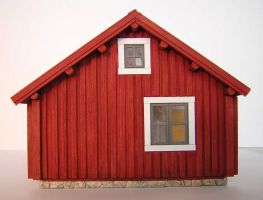
Small houses like this one were common in large parts of Sweden at least from the 18th century and on. Originally, they were log houses with sod roofs. The exterior was neither painted nor covered with siding, so the logs weathered to a silvery grey. During the first half of the 19th century, siding was often added. Later, in the second half of the 19th century, they finally got painted (the red color was favored almost everywhere). About the same time, the sod roofs were replaced by clay roof tiles.
Construction
I built the entire house from 2 mm (5/64") plywood. I glued 2 mm thick sheet of balsa to the exterior, and treated them with a wire brush. Then I glued on 3/32" to 1/8" wide strips of 1 mm balsa, and used the wire brush bring out the grain on the strips too. The paint is FolkArt's Barnyard red.
The "stone" foundation is made from Paperclay - I tore small pieces and applied edge to edge. When dry, I painted it with diluted FolkArt paint. I used natural colors like black, ochre, iron oxide (red) etc.
For the roof, I used a 1:50 scale molded plastic sheet of tiles. It came in terracotta color, but was so shiny and plastic-looking that I had to paint it. I basecoated it so the paint would stick, then used terracotta paint toned down with a bit of brown.
Interior
I based the interior on photos of furniture used in peasants' homes during the 19th century, plus some Swedish source books on restoring old houses.
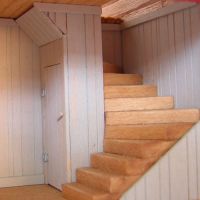
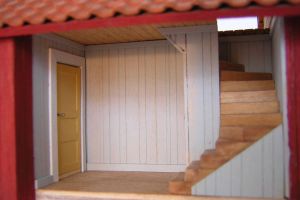
Hallway
Part of the front wall can be removed, to reveal the hallway. There's a closet under the stairs.
I wanted to build the house with an open back for easy access, and normally that would've meant the hallway was completely enclosed, as it's at the front of the house.
But thanks to the removable wall I could copy the traditional floorplan exactly, allow all rooms to be accessed and viewed, and still have the front look "right".
The removable panel stretches from the right-hand corner to slightly left of the door.
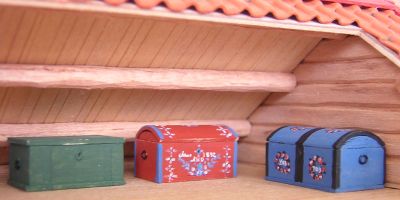
Attic
The attic was unfurnished and used for storage only. Each grown-up family member had their own chest for keeping their clothes and other personal belongings in.
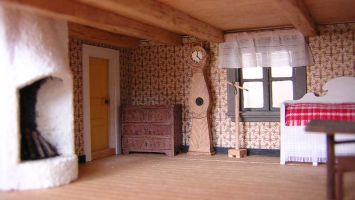
Living room
The family slept, ate, and worked in the living room. The door in the corner leads to the hallway. To the left is a fireplace. The splinter light provided additional working light on evenings and in the winter (it's currently placed by the window, to be out of the way during daytime).
Furniture was made from softwood, usually painted. Sometimes it was faux grained like this clock and chest of drawers. At this time, chests of drawers were beginning to replace chests in peasant households.
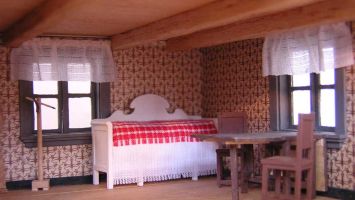
Gate-leg drop-leaf tables were very common in 19th century peasant homes, and so were extending beds. The table was placed by the window and the beds were arranged symmetrically along the walls.
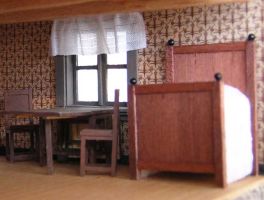
This family has one 'Gustavian' bed (the white settle-type thing), that extends width-wise, and one 'Imperial' bed (the brown one shown below) that extends length-wise. These different type beds emerged in the Gustavian and French Empire periods respectively, hence the names. The parents would've had the (more modern) Imperial bed, and a couple of the children would've slept head to toe in the Gustavian bed. The Imperial bed is likely a hand-me-down from a middle-class family.
During the day, the beds were piled high with mattresses and pillows covered with a bedspread.
At night, most of the mattresses were placed on the floor so everyone had somewhere to sleep. Most
familys were very large by today's standards, and there were seldom enough beds for everyone.
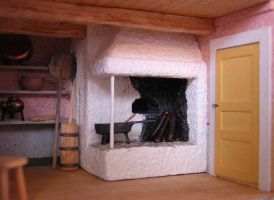
Kitchen
The masonry fireplace is typical of the 18th and 19th century. The gap in its back wall is the baking oven (in hindsight, I think it ought to have an iron door). It was heated with a fire or glowing embers before the bread was baked. A three-legged pan with a wooden spoon in it stands on the hearth.
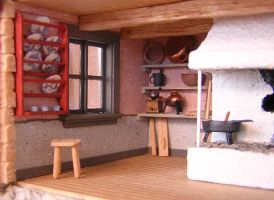
The wall shelf holding dinner plates and some coffe cups is a typical feature of old Swedish kitchens. In the back of the room, shelves are holding a sieve, a copper pan, a mortar and pestle, a wooden bowl (actually made from a seed pod), a coffee grinder and a three-legged coffee pan. Below the shelves, mangling utensils are leaning against the wall. Linen items were rolled around the dowel, and then you put it on a flat surface and ran the flat tool back and forth on top of it, making the dowel roll and eventually pressing the cloth flat.
In the left edge of this pic, you can see the logs that are supposed to make up the walls of this house. I needed to finish the edges somehow and faking the logs that would have been inside the walls seemed
neat.

Meet the family
Eventually, I made a family to live in the cottage. Here they're depicted in front of their home (Photoshop trickery, really, as the house was literally on a different continent). Of course a real-life family would have several more children in the coming years. Maybe that's why the mother's dress doesn't quite fit in the stomach area?
You can read about their clothes on my Swedish costumes page.
